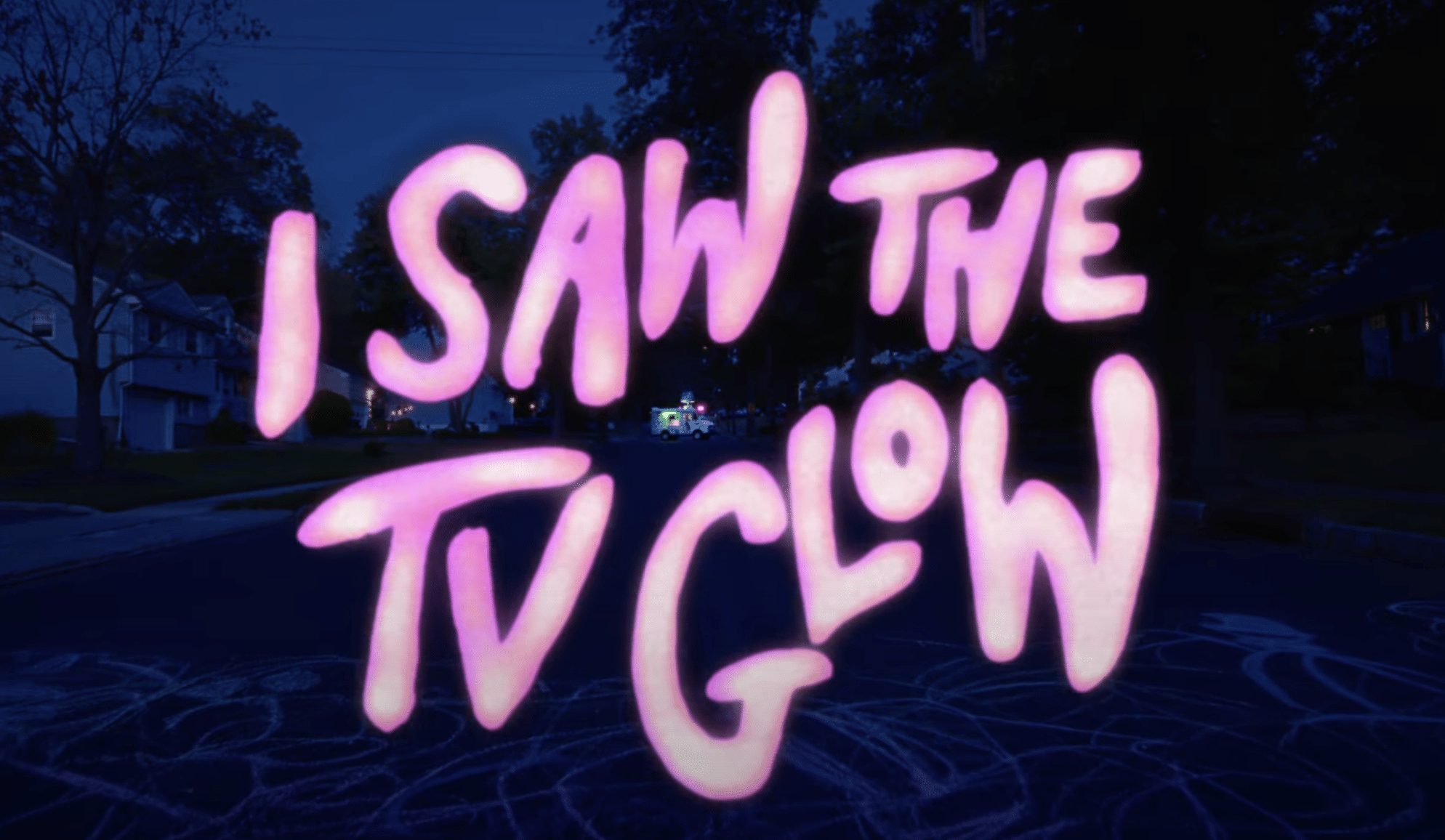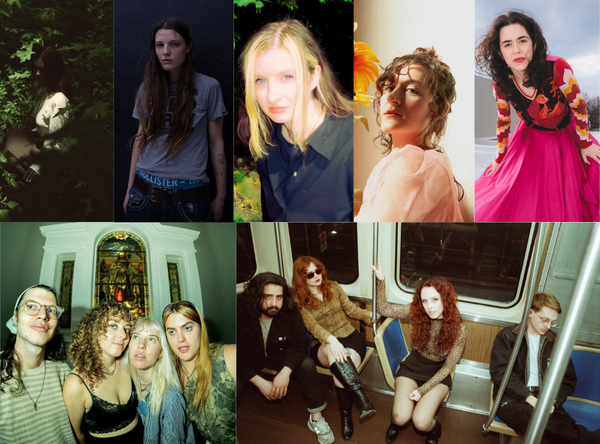I Saw The TV Glow: the Transient Peak review
Review of Jane Schoenbrun’s latest psychological drama

Hi! Welcome to Transient Peak, where I usually interview artists about their work. This is my first non-Letterboxd longform film review since my last newsletter 3 years ago, on Sia’s terrible autism movie Music. I saw this at a Q&A screening on Wednesday, where I got a lot of the information I use here, and immediately knew I’d have to go long. Not too long, but long, hopefully without too many spoilers.
I recently interviewed soundtrack artist Maria BC with their engineer ODAE, so if you’re new here go read that, and subscribe while you’re at it :)
In I Saw The TV Glow, Owen (Justice Smith) bonds with his classmate Maddy (Brigette Lundy-Paine) over the Pink Opaque, a Buffy/Supernatural-esque show where two women share a mental link and fight monsters of the week appointed by the nefarious Mr. Melancholy. The pair become obsessed, and see themselves in the show – not that Owen would admit it to himself, lest he get caught watching by his abusive father (Fred Durst, yes of Limp Bizkit). As Owen gets older, something gnaws at him; the Pink Opaque felt realer than his adolescence did. Reality and fiction begin to blur.
I Saw The TV Glow is billed as horror, but that feels like a stretch; yes, there are scenes with flashing lights and piercing sound design, but those are few and far between. It's best described as a surreal, tense psychological coming of age drama, one that gradually tricks an unsuspecting audience into watching a trans narrative. Beyond that, it’s a gorgeous character study of two lonely people finding themselves and possibly losing themselves in the art they consume. There’s a maturity I’m not used to seeing with art about young queer people, as Schoenbrun empathetically deals with big teen emotions without getting absorbed into them. Their previous film We’re All Going To The World’s Fair, as striking as it was, now plays like a proof of concept, a minimalist prelude to their true capabilities.
Owen switches from young actor Ian Foreman to the 28-year-old Justice Smith as early as 9th grade; suddenly thrust into an adult male body, Smith looks achingly uncomfortable, like he’s trying to crawl out of his own skin; I winced so many times in recognition, particularly when he visibly yearns to be closer to Maddy but is frozen in place, remembering how he’s perceived. Maddy is genuinely kind to Owen, complementing his soft-spoken nature with enough intensity for the both of them. There’s a reason why Owen is so drawn to a show where the two women are irrevocably bonded, tying his lack of self to someone bursting at the seams with emotion.
Wanting an older kid to recognize you and think you’re as cool as them is a universal experience - The Perks of Being a Wallflower comes to mind, as it often does during the early stretches of this film. Owen does not want to be Maddy, but there’s absolutely an envy of how women talk with one another, particularly in an early scene at a sleepover where Owen watches her and her friend watch the show. Maddy, to her credit, clearly understands something in him; I loved when she drew the Pink Opaque logo on Owen’s neck, and not just because it’s a future go-to tattoo for trans people. When you’re a repressed egg (put simply: a trans person in denial), those acts of physical affection are life-changing, affirming a real connection between you and the other person that transcends gender.
Look closer and the relationship between the two characters is more complicated: Maddy’s both the first person to really see Owen and someone who may not, strictly speaking, see reality. Does Maddy even see Owen, or does she, in her reality-blurred state, just see Pink Opaque leads Tara and Isabel, and she needs someone to join in her shared psychosis? It doesn’t matter ultimately; Owen will figure himself out one way or another, even if he tries to run away from it. If you'll allow this reference, Owen's journey parallels another recent queer breakthrough: "you have to stop the world just to stop the feeling."
I Saw the TV Glow is not (just) special because it’s the first time an openly trans person has been able to operate on this large a scale, on something wholly original. It’s special because it’s fucking good. Maybe it’s because I recently watched low-budget ramshackle charm of Hundreds of Beavers and the People’s Joker (both of which use their limited resources to make something beautiful in their own eccentric ways) but this looks enormous, even as $10 million is low by most modern standards; the cinematographer Eric K. Yue waived his fee so he could shoot on 35mm, with additional footage printed to VHS and occasionally composited back in. I haven’t seen dysphoria depicted so vividly with this amount of precision before, and it’s a triumph on those grounds alone. If that was all Glow did, it would be impressive, but the visual aesthetic doesn’t stop there. Several scenes subtly implement these stunning CG flourishes (I won’t spoil) that show what Schoenbrun can do with a big budget. My personal favorite shot is young Owen overwhelmed inside a gym parachute, echoed later in the film within a makeshift planetarium.
That confidence stretches to how Schoenbrun treats older media. There’s a recurring theme in Schoenbrun’s work, where they affectionately rib other forms of media for its flaws – it’s a flex in a movie this slick, but it never feels like punching down. That VHS footage looks like a legitimately interesting show, with special effects that are obvious but somehow terrifying because of that obviousness. World’s Fair’s funniest bit involves an over-the-top YouTube video where someone gets sucked into the computer. Similarly, a laugh in TV Glow comes from Owen realizing how cheesy the show actually is when he gets older. When Schoenbrun uses footage of mockbuster Transmorphers at the theater where Owen works might be a little too cute for a movie so precisely stylized, but it’s a natural extension of this fascination. All of this keeps things tethered to reality, finding relatable nostalgia to ease audiences in before hitting them with the heady stuff.
Schoenbrun ultimately bridges the gap with a deliberate, even self-conscious concession to cis audiences; specifically, insert shots of Owen’s discovery. Conveying your internal world to others is inherently impossible, and that’s part of why questioning gender is so stressful. How do I tell myself? How do I tell the world without ‘proof’? What if they never saw any signs? With their evocative depiction of dysphoria, Schoenbrun invokes a tenet of both filmmaking and transition: You can’t tell them, so you have to show them. When Schoenbrun finally does tell the audience what’s going on, it’s clarifying for people who don’t get it, and satisfying for people who do.
The other way the movie extends its hand is its soundtrack, explicitly aiming to be the modern version of 90s TV show soundtracks with acts like Phoebe Bridgers and Caroline Polachek in place of Garbage or, uh, Paula Cole? Broken Social Scene’s “Anthem For A Seventeen Year Old Girl” - as performed by alt-pop darling Yeule - is essentially the theme of this movie, an indie classic of adolescent yearning. It’s also a devastating song if you were never a seventeen year old girl (ask me how I know) and Yeule’s version captures both the hopeful wistfulness and the pain of being outside it. It’s a credit to Schoenbrun that the music never gets in the way of the film’s story; I was genuinely moved hearing Maria BC’s voice in one scene when I could have easily been taken out. At one point, the movie basically stops for Bridgers and her old band Sloppy Jane to perform, and the sudden appearance is, amusingly, the film’s only true jumpscare.
I wasn’t sure why the performance was played in full, other than ‘hell yeah Phoebe’s here let’s do it’, but it can’t be lost on anyone that Bridgers’ fans overidentify with her, and her song “Punisher” imagines her own encounter with a hero: “I wouldn’t know where to start/I wouldn’t know when to stop.” The connections we have to media often outlast the original works’ intent, for better and for worse. There’s nothing wrong with loving hard or identifying with art – closeted college me identified so strongly with the Good Place’s upbeat human-Siri Janet it was honestly pretty cringeworthy – but there’s definitely something wrong when the identification crosses over into dangerous obsession. The movie makes this distinction clear, as tempting as it might have been to send Maddy and Owen into a Heavenly Creatures-like magical fantasy in the world of Pink Opaque.
I Saw The TV Glow is not 100% perfect; the ending does feel somewhat rushed, and there’s an overuse of narration that’s still unsettling but a little too obvious when the rest of the movie thrives in mystery. Some might even think the film stops when it feels like it’s picking up - selfishly, I wish it was at least twenty minutes longer just so I can live in it more - but I almost wonder if that’s a reflection of where Schoenbrun was at the time, barely post-HRT when they wrote the script. Closure would take away from the message: TV won't save you. That older girl won’t save you. You’ll want to be the girl on the screen, the girl next to you, but you can’t be. You’re stuck as yourself. But there’s always potential to draw who you want to be and who you currently are closer together - Schoenbrun all but breaks the fourth wall when the phrase “There is still time” appears on the sidewalk, which you can only get away with if you know you’re going to change some lives.
It’s bittersweet to have a potential egg-cracker come out right as teens will likely be forced to stay in the closet. I harp on the backlash in virtually every trans-related piece I write because I’m scared, even as A24 pouring millions of dollars into a trans filmmaker is beautiful to see. Might “There is still time” ring hollow when time feels like it’s running out, given the looming threats of KOSA an Project 2025? I don’t know. In the best case scenario, I Saw The TV Glow becomes as dated as the Pink Opaque, after countless trans filmmakers (including, of course, Schoenbrun themself) fearlessly render their weirdest ideas on screen. Maybe we’ll look back at this film and cringe, too, but the themes of loneliness and yearning will hit no matter who watches or when they see it.
If you like this, support me on Ko-fi or subscribe to the paid version of my newsletter!
I’m playing a handful of shows under the stage name The Answers in Between: May 4th at 18th Ward Brewery, May 31st at Brooklyn Music Kitchen, and July 22nd at Sleepwalk Bar with opening act Hey Rel. Would love to see you there.


